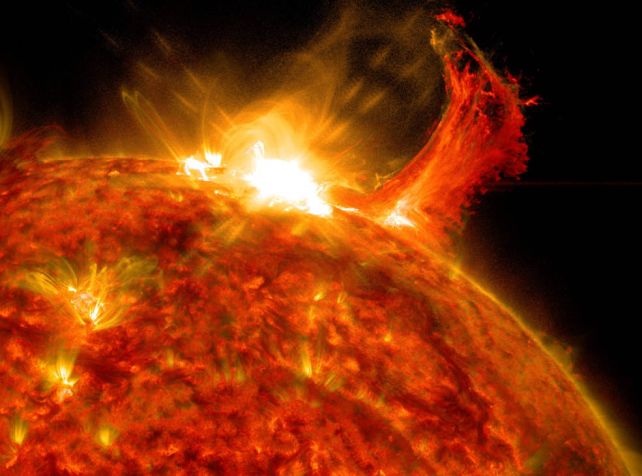The most energetic light ever seen emanating from the Sun has just been detected, creating a new puzzle for solar physicists to solve.
A 6-year observing campaign by more than 30 institutions across North America, Europe, and Asia has resulted in the first ever detection of solar gamma radiation in the teraelectronvolt (TeV) range.
But, contrary to what you might expect, it did not correlate to heightened solar activity; or, indeed, any solar activity. Rather, the Sun was pretty calm at the time of the detection, and our current models of the Sun can't quite account for it.
The Sun is the most intensely studied star in the cosmos. We have observations that span the entire spectrum, from low-frequency radio waves to the most energetic light in the Universe, gamma radiation. For all that, though, there's a lot we don't know about our home star. Details about its processes still elude us.
We know that magnetic fields are important, playing a crucial role in pretty much all the solar activity we observe, but the mechanisms thereby are poorly understood. We study the light emitted by the Sun to try to gain a deeper understanding.
The High Altitude Water Cherenkov (HAWC) observatory in Mexico is one of the tools we use for studying the gamma and cosmic radiation from space that collides with Earth's atmosphere.

The atmosphere blocks this radiation from reaching us, but doing so can produce high-energy particles that can be detected in the dark, and their parent gamma ray energy and direction calculated from that detection.
"HAWC is among the few detectors capable of observing the Sun in the TeV range," writes the international HAWC Collaboration that conducted the research. "Its large field of view and high livetime fraction allow continuous exposure as the Sun transits across the sky."
In data collected using HAWC between 2014 and 2021, the researchers detected emissions ranging between 0.5 and 2.6 TeV (one TeV is a trillion electronvolts) coming from the direction of the Sun. Their new analysis pipeline determined that this emission was coming from the Sun, with a 6.3 sigma probability.
It's not the highest energy light ever seen in space. That record belongs to an observation of 450 TeV gamma rays coming from the direction of the Crab Nebula several years ago. But it is a new hit for our own star.
"After looking at six years' worth of data, out popped this excess of gamma rays," says Mehr Un Nisa, an astroparticle physicist at Michigan State University.
"When we first saw it, we were like, 'We definitely messed this up. The sun cannot be this bright at these energies.'"

We know that sometimes, the Sun gets rowdy. It lashes out with solar flares and coronal mass ejections. But the Sun does not just emit light. It gets hit by it, too. Cosmic rays from the wider galaxy are constantly streaming through space. Here on Earth, these cosmic rays interact with the atmosphere to produce a gamma ray glow.
A similar process is thought to take place on the Sun. Galactic cosmic rays collide with nuclei in the solar atmosphere, in the gigaelectronvolt (1 billion electronvolts) range.
The team thinks that the TeV emission is probably a result of this interaction. They also took a look at the GeV data collected by HAWC and NASA's Fermi LAT gamma-ray space telescope, and found that the GeV emission was brighter and more copious than expected during the Sun's calm periods.

What we don't know is how the emission gets so bright. It doesn't match theoretical models. Given how lousy the Sun is with messy magnetic fields, it's probable they play a role. Indeed, a paper published earlier this year proposed that the solar magnetic fields act as accelerators for cosmic ray electrons to produce synchrotron gamma radiation.
More modeling will need to be done to determine exactly how this is accomplished, though.
"Models of cosmic ray interactions in the Sun … already under-predict the observed gamma-ray flux from the Sun in the GeV range," the HAWC Collaboration writes. "Our observations highlight the need for a revised framework that can explain the anomalous excess of gamma rays from the Sun also in the TeV range."
The research has been published in Physical Review Letters.
